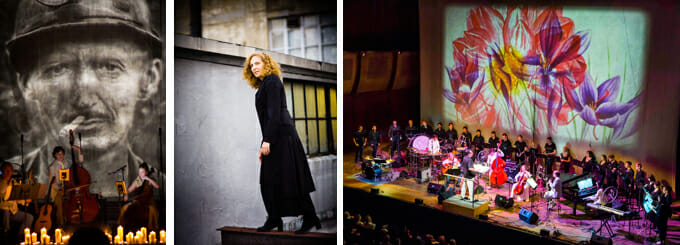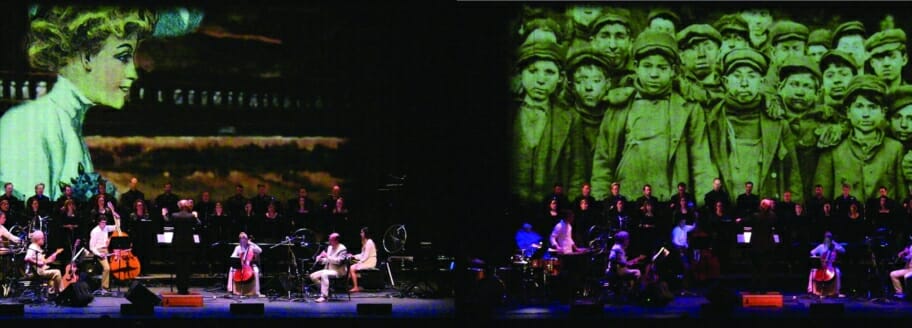Julia Wolfe’s: Anthracite Fields
Featuring the Bang on a Can All-Stars & SATB Choir
“[Anthracite Fields] captures not only the sadness of hard lives lost…but also of the sweetness and passion of a way of daily life now also lost. The music compels without overstatement. This is a major, profound work.” – Mark Swed, Los Angeles Times.
VIDEO: The “Stay Tuned” TV program on NE Pennsylvania’s WVIA featured on our moving performance of Anthracite Fields in PA Coal Country:
Julia Wolfe speaks about the creation of Anthracite Fields, before its premiere with the Mendelssohn Club in Philadelphia:
For her work Anthracite Fields – a Pulitzer Prize-winning oratorio for chorus and the Bang on a Can All-Stars – composer Julia Wolfe, a 2016 MacArthur Fellow, drew on oral histories, interviews, speeches, geographic descriptions, children’s rhymes, and coal advertisements to create a work that gives an intimate look at a particular slice of American life.
Cited by the Pulitzer committee as “a powerful oratorio for chorus and sextet evoking Pennsylvania coal-mining life around the turn of the 20th Century,” the work premiered at the Mendelssohn Club of Philadelphia in April 2014 followed by a performance at the NY PHIL BIENNIAL in May 2014. It was met with rave reviews. The New York Times wrote, “In Ms. Wolfe’s polished and stylistically assured cantata, the overall coherence of the musical material helped her expressions of outrage to burn cleanly and brightly.” The Philadelphia Inquirer praised the piece for creating “an alternate universe.”
“My aim with Anthracite Fields is to honor the people who persevered and endured in the Pennsylvania Anthracite coal region during a time when the industry fueled the nation, and to reveal a bit about who we are as American workers.”
Named after the technical term for the purest form of coal, anthracite, Anthracite Fields was written after Wolfe did extensive research about the coal mining industry in an area very near where she grew up in Pennsylvania. She writes, “In some ways the piece is a return to my small town Pennsylvania roots. In looking north – the left turn onto route 309, the road-rarely-taken – I delved into a local history.”
Press:
Read LA Times article about Anthracite Fields.
Read NY Times article.
Read SF Chronicle review.
Listen to Wolfe on NPRs All Things Considered.
Read NPR interview with Wolfe.
Read NY Times article about her Pulitzer award.
Audio and Program notes:
Audio streaming, program notes and texts available on Julia Wolfe’s website.
Recording:
The album Anthracite Fields is available on Cantaloupe Music.
Booking and Technical Information:
Anthracite Fields is written in five movements:
Foundation: The singers chant the names of miners that appeared on a Pennsylvania Mining Accident index 1869-1916. At the center of Foundation is text from geological descriptions of coal formation.
Breaker Boys: In the center of this movement are the words of Anthony (Shorty) Slick, who worked as a breaker boy. The interview is taken from the documentary film America and Lewis Hine, directed by Nina Rosenblum. Hine worked for the National Child Labor Committee and served as chief photographer for the WPA.
Speech: The text is adapted from an excerpt of a speech by John L. Lewis, who served as president of the United Mine Workers of America.
Flowers: Flowers was inspired by an interview with Barbara Powell, daughter and granddaughter of miners. In one interview Barbara said, “We all had gardens,” and then she began to list the names of flowers.
Appliances: Even today coal is fueling the nation, powering electricity. The closing words of Anthracite Fields are taken from an advertising campaign for the coal-powered railroad. In 1900 Ernest Elmo Calkins created a fictitious character, a New York socialite named Phoebe Snow, who rode the rails to Buffalo. It used to be a dirty business to ride a train. But with the diamond of coal her “gown stayed white from morn till night, on the road to Anthracite.”
Anthracite Fields was commissioned through Meet the Composer’s Commissioning Music/USA program, which is made possible by generous support from the Mary Flagler Cary Charitable Trust, New York City Department of Cultural Affairs, the William and Flora Hewlett Foundation, and the Helen F. Whitaker Fund. Additional support was made possible through the Mendelssohn Club of Philadelphia Alan Harler New Ventures Fund; The Presser Foundation; The Pew Center for Arts and Heritage; the National Endowment for the Arts; The Musical Fund Society of Philadelphia, and the Aaron Copland Fund for Music.
Scenography for Anthracite Fields by Jeff Sugg.
Photo (top) credits L to R: Derek V Smythe, Peter Serling, Chris Lee.


